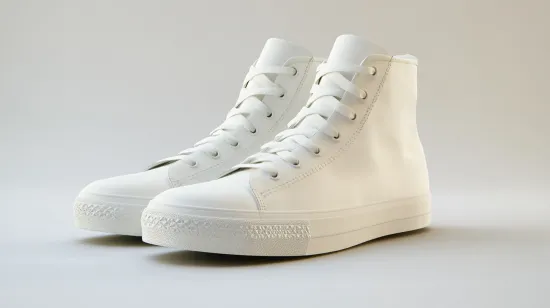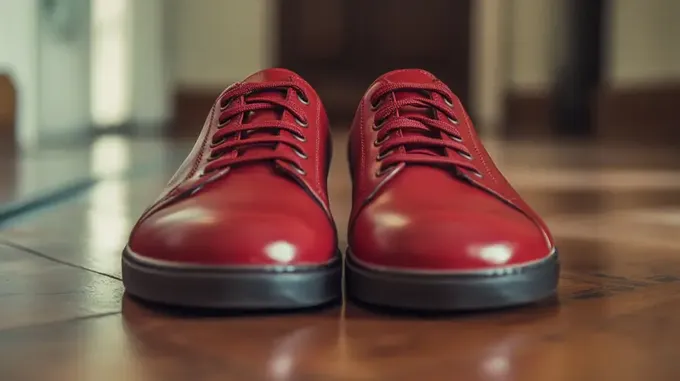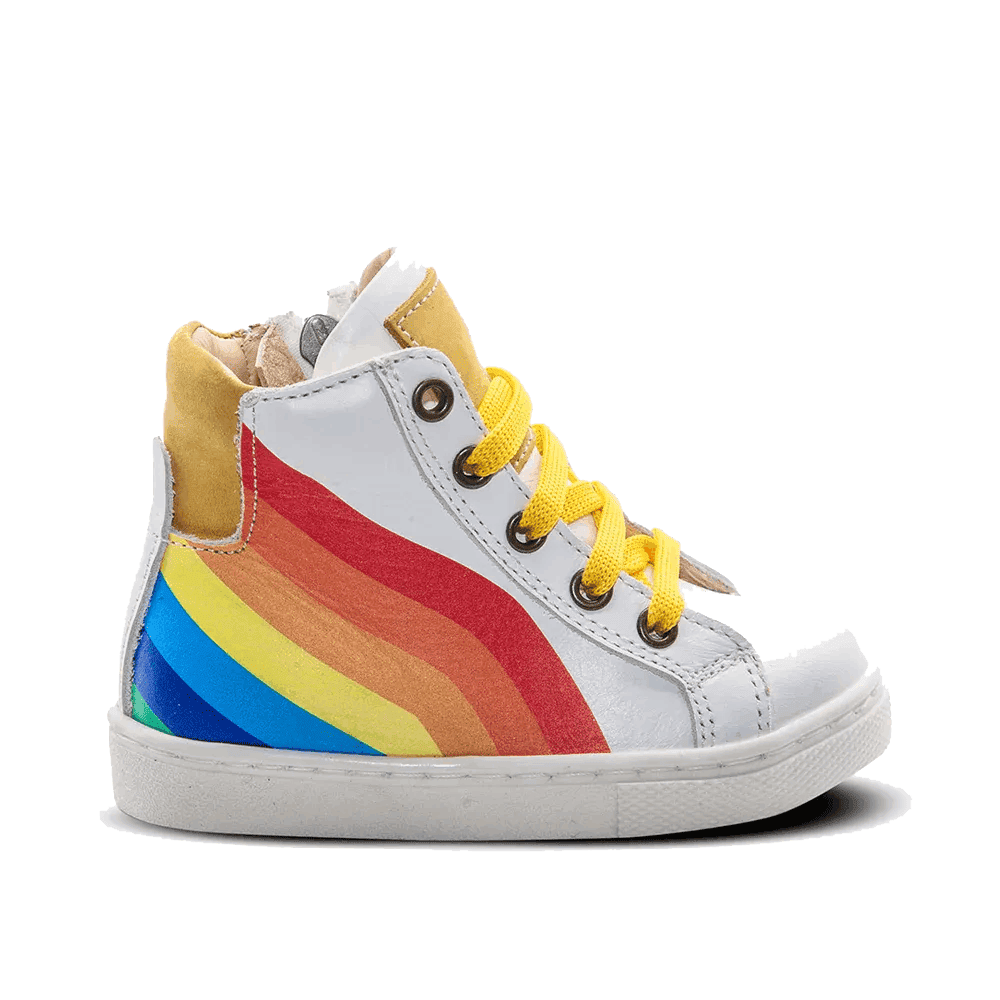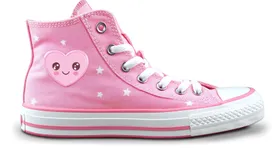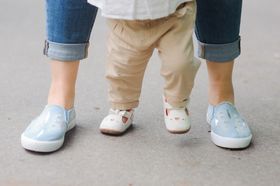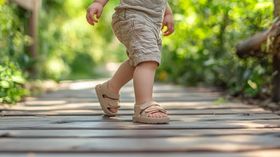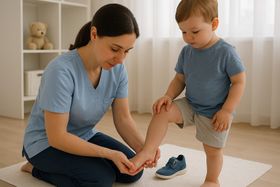High-Tops vs. Low-Tops: Which Protect Your Kids' Feet Better?
High-tops cover the ankle and offer more stability, while low-tops sit below the ankle and allow freer movement. Neither prevents ankle injuries better than the other—what matters most is proper fit, your child's activity level, and foot development stage.
Updated December 1, 2025
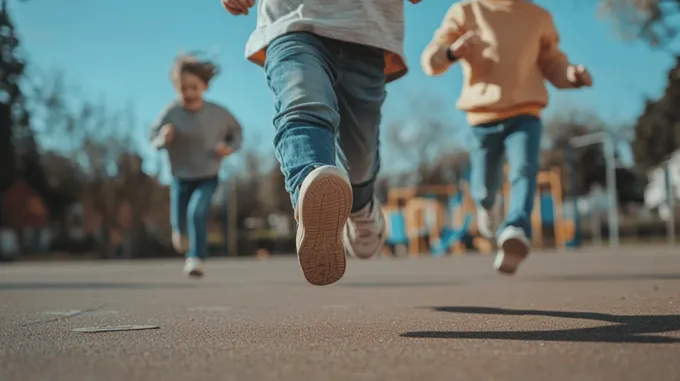
You're standing in the shoe store staring at two pairs of sneakers. One comes up high around the ankle. The other sits low. You may wonder which one actually protects your kid's feet. As a qualified physiotherapist, I've analyzed the evidence to help you decide.
Comfort and safety are crucial factors supporting your child's foot development. Let's explore ankle support, traction, and fit so you can make an informed choice for your child's needs.
High-Tops vs. Low-Tops: Understanding the Differences
High-Tops
High-tops are shoes with collars that extend above the ankle. They cover both foot and ankle, offering a steady base with a firm heel counter and padded ankle support.
High-tops provide static support—the shoe itself holds your child's ankle in a stable position. Think of it like a gentle hug around the ankle that limits extreme sideways movement.
Low-Tops
Low-tops have collars that sit below the ankle bone. Your child's ankle moves freely without restriction. The ankle joint can rotate, flex, and move through its full range of motion.
Low-tops rely on dynamic support; your child's own muscles and reflexes stabilize the ankle. There's no physical barrier from the shoe, so the ankle responds naturally.
How High-Tops Provide Ankle Support
Shoes with ankle support reduce the risk of injuries affecting your child’s mobility, performance, and quality of life. They can improve stability, prevent excessive stress, and reduce swelling and pain after an injury.
High-Tops vs. Low-Tops in Ankle Support
If you're wondering whether high-tops prevent ankle injuries, these are shoes with collars that extend above the ankle. They cover both foot and ankle, offering a steady base with a firm heel counter and padded ankle support.
High-tops provide static support—the shoe itself holds your child's ankle in a stable position. Think of it like a gentle hug around the ankle that limits extreme sideways movement.
Low-tops have collars that sit below the ankle bone. Your child's ankle moves freely without restriction. The ankle joint can rotate, flex, and move through its full range of motion.
Low-tops rely on dynamic support, your child's own muscles and reflexes stabilize the ankle. There's no physical barrier from the shoe, so the ankle responds naturally.
The taller collar creates a mechanical barrier against extreme ankle rolling. When your child's foot lands awkwardly, the shoe's upper material resists the ankle tilting too far.
Research shows high-tops show a significant advantage in preventing ankle inversion and ankle pain compared to low-tops [1].
For everyday wear and developing feet, low-tops often work better. They allow the full range of ankle motion your child needs to build strength naturally.
Low-tops are lighter, which matters for little legs. Your child can run longer without the extra shoe material weighing them down.
They're easier for independent dressing. Toddlers learning to put on their own shoes have an easier time with the wider opening.
Low-tops are shoes that provide better breathability since there's less material around the ankle, keeping feet cooler during active play.
Evaluating Traction and Safety with High-Tops vs. Low-Tops
The traction of the shoe depends on the kind of sole it has. For example, rubber soles have a better grip than leather ones. When choosing a sneaker, you should also consider the type of surface, weather conditions, and foot stability.
High-Tops vs. Low-Tops: Difference in Traction and Safety
- High-Tops: With more surface area on the outsole, high-tops can provide more grip and stability. Most of them also have a higher collar, which can help to prevent the ankle joint from rolling.
- Low-Tops: These shoes are more lightweight and flexible, making them more comfortable for some kids. They may also provide less support or traction than high-top sneakers.
Overall, the difference in traction between high-top and low-top shoes is relatively small. But high-tops may be a better choice if your kid plays a sport that involves a lot of lateral movement, like basketball.
On the other hand, low-top shoes may be a better choice if you are looking for a lightweight and comfortable shoe with a good range of motion.
High-Tops vs. Low-Tops for Flat Feet
Parents often ask if high-tops are better for kids with flat feet. Not necessarily.
Flat feet need arch support and heel stability, which come from the insole and heel counter, not collar height. A well-designed low-top with proper arch support works just as well.
Look for these features regardless of collar height:
- Firm heel counters
- Removable insoles for custom orthotics
- Wide toe boxes
When to consult a podiatrist:
- You notice severe overpronation
- Flat feet persist past age 6 with pain
- Ankle injuries keep recurring
Making an Informed Decision on the Right Shoe
While low-tops offer enhanced mobility and dynamic support, high-tops prioritise stability, static support, and potentially better traction and safety. Your decision should be based on your child's needs, preferences, aesthetics, comfort, durability, and versatility.
Check out First Walker's high-tops toddler shoes collection to balance style, comfort, and safety and ensure your child's footwear looks good and supports their growing feet in the best possible way.
References
1. Ricard, M. D., Schulties, S. S., & Saret, J. J. (2000, March 1). Effects of High-Top and Low-Top shoes on ankle inversion. https://pmc.ncbi.nlm.nih.gov/articles/PMC1323436/
Disclaimer: First Walkers' information is intended for educational and informational purposes related to toddler footwear and feet. We encourage you to consider individual circumstances and consult qualified orthopaedists about specific conditions.
FAQs
Are high-tops good for your feet?
High-tops aren't inherently better or worse for feet than low-tops. What matters is proper fit and matching the shoe to your activity. High-tops provide a feeling of stability and work well for sports with lateral movement, like basketball. For everyday wear and developing toddler feet, low-tops often work better because they allow natural ankle motion that builds strength.
How do I know which size toddler high-top trainers to buy?
Measure your toddler's feet every 2-3 months since they grow one full size every 3-4 months. Leave a thumb's width (1-1.5 cm) of space between the longest toe and shoe end. Make sure the heel doesn't slip when walking and that your child can wiggle toes freely. Try shoes on in the afternoon when feet are slightly swollen. Check the ankle collar—it should feel snug but not tight or restrict movement.
Why are high-top shoes better?
High-tops aren't universally better—they're better for specific situations. They work well for basketball and court sports because of slightly better traction and the feeling of ankle support during quick pivots. They also help on uneven hiking terrain. But for everyday wear, running, and toddler development, low-tops are often the better choice because they're lighter and allow natural ankle movement.
Do high-tops protect ankles?
Not significantly more than well-fitted low-tops. Research shows high-tops don't prevent ankle injuries better than low-tops. True ankle protection comes from muscle strength, proprioception, and proper fit—not collar height. High-tops create a mechanical barrier against extreme ankle rolling, but they can also weaken the natural muscles and reflexes that prevent sprains long-term.
Are there high-tops that are good for flat feet?
Yes, but collar height isn't what helps flat feet—arch support and heel stability are. Look for high-tops (or low-tops) with firm heel counters, built-in arch support, removable insoles for custom orthotics, and wide toe boxes. Focus on the insole design and heel counter rather than whether the shoe is high-top or low-top.
Why are high-tops used for basketball?
Basketball involves lots of lateral movement, quick direction changes, and jumping—activities where players feel more confident with extra ankle coverage. High-tops provide slightly more traction and the psychological comfort of support during aggressive play. However, research shows they don't actually prevent ankle injuries better than quality low-tops.
Are high-tops bad for toddlers?
High-tops aren't bad, but they're usually unnecessary for toddlers. Toddler ankles need freedom to move and build natural strength. Low-tops are lighter, easier for toddlers to put on themselves, and support natural development better. Reserve high-tops for specific activities like hiking rough terrain or if your pediatrician recommends extra support during injury recovery.
Who should wear high-top sneakers?
Kids who play basketball, tennis, or other court sports with lateral movement benefit from high-tops. Children hiking on uneven trails get extra protection against ankle rolling. Kids recovering from ankle injuries (with medical guidance) might find the extra support reassuring. For everyone else—especially toddlers and young children doing everyday activities—low-tops usually work better.
